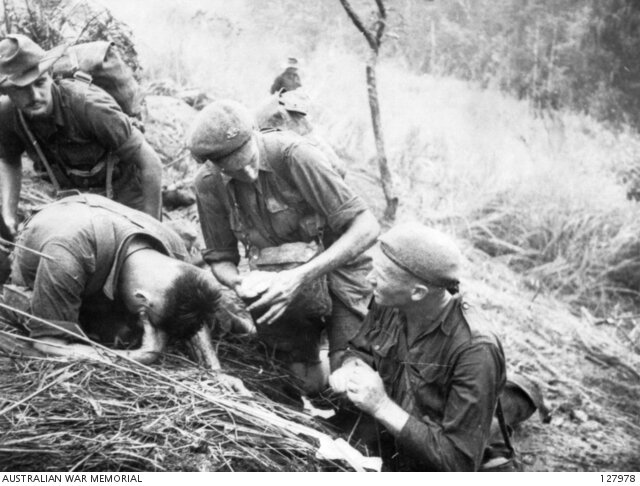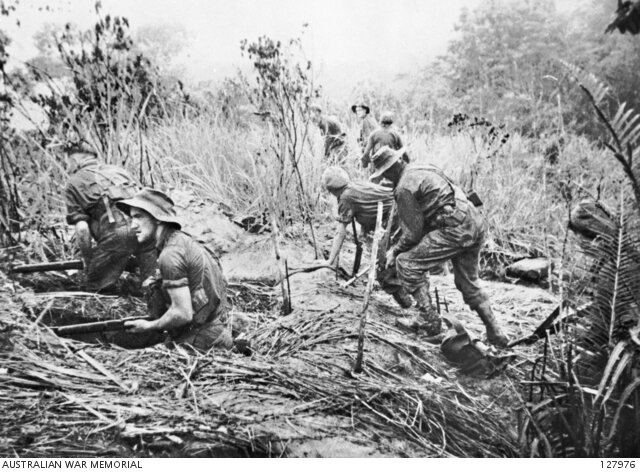Another wartime story… different war… different research – same story

this is the verbatim story of a WW2 Commando (they hated being called that – they were the Independent Companies!)
WARNING: This article and pages it links to, and contains, descriptions and images of war and violence.
Noel Anthony Carey was interviewed by Kevin Dickson in 1995 at the Twin Towns RSL club for a series of oral histories of veterans’ experiences of World War II.
Noel was born in Maclean, New South Wales in 1919; his father was a shire engineer. The family moved to Sydney when his father became the shire engineer for Glebe Council and Noel was educated at Watson’s Bay Primary and Marist Brothers College (intermediate), then, against his father’s wishes, he went to East Sydney Technical College to study art/drawing as he wanted to be a commercial artist/illustrator. Three years apprenticing in an artist’s studio and he was out of work at the end of the Depression (1937/8) until he gained his first job drawing for Consolidated Designs (posters and signs on buildings).
The war broke out, and late 1939/early 1940 saw Noel try for Royal Australian Air Force (RAAF) air crew enlistment but without a leaving certificate that was problematic – no maths qualifications.
“My dad had always said: ‘you’ll end up on the pick and shovel’,” he recalled.
That would have been a hard thing for a young man to hear – and to remember.
He was called up for National Service, joined the ‘choccos’, Civilian Military Force (CMF), heard the stories of some of the boys back from Malaya and the Middle East, realised that whilst he trained with the Sydney University regiment on up-to-date equipment, these boys had been fighting using 18 pounders and 4.5 Howitzers left over from WW1. Unable to square that in himself, Noel transferred from the CMF to the country’s ‘real’ defence force, the Australian Infantry Force (AIF) and volunteered for the Independent Companies being formed.
That sense of how much more was being sacrificed by those serving overseas pervades every single first person account of WW2 that I have read.
So – he was selected, went for preliminary training at Wilson’s Promontory (Victoria) where he studied demolition and small craft navigation, as well as all the usual in-country work. Volunteering for action by the end of 1942, he and 19 others were told to get their gear, trucked back to Melbourne, put on a midnight train to Brisbane and went to Binna Burra in the MacPherson Ranges. Here, they formed D platoon of the 2/3rd Independent Company and jungle trained at O’Riley’s for two to three months, living in two-man tents on hard rations, climbing mountain peaks, and forced marching to Cavill Ave, Surfer’s Paradise, which was, as he said, “just a village then”. They moved to Pumicestone Passage, and trained for amphibious landings on Bribie Island using both collapsible canvas boats and abseiling down the sides of ships to the sea.
He was 21 years old – old for the unit. Most of the boys were 18, 19 years old – the 25 year olds were called granddad.
It was completely secret. There was no contact with home, there was no leave. There was only the Company and that was a very strong bond. According to Noel, the officers were fair, allowed the men input, but didn’t “put up with any rot”. They kept morale up – even though their language was “shocking.” On parade, one sergeant said: “You bastards listen to me now! I have two messages for you men! For Chrissake, read North-West bloody Passage – I’ve got twenty copies and I want all of you to have read it – because we’re going to make it look like a bloody Disney film! And write to your bloody mothers once a bloody week! Parade dismissed!”
The 2/3rd Independents, with the 2/5th, 2/6th, 2/7th Battalions and the 2/11th Battalion (editor: I may have mis-heard the Battalions – some of the tapes are 23 years old) re-took the airstrip at Wau after four/five days of bloody fighting and mopping up. The Independents then “mopped up the Japs as they retreated over the mountains,” Noel said.
At first there was no resistance, but they kept coming across Japanese sick or wounded lying beside the track. The retreating Japanese forces had simply abandoned any soldier who was immobilised. The Independents’ orders were: “no prisoners”.
“That’s when it became pretty horrific – we just had to kill anyone we came across,” Noel said.
And tactically, they were forbidden from “drawing the crabs” – making a noise – so they couldn’t shoot the wounded Japanese; they had to bayonet them.
After a pause, Noel continued, “you couldn’t forget their eyes and a lot of them were saying they were Chinese – Christians – coolies from Hong Kong and they spoke a little English… gradually it had a terrific influence on us”… Noel described it as a different attitude then – but he always felt that you did this to them, you had no redress if they did it to you.
This was January 1943 and he and the company were campaigning in the mountains, harassing and pursuing Japanese forces, until September of that year. No days off, no change of clothes, no return to a home base really – they couldn’t be relieved as they were “behind Jap lines”. It was five men to a tin of bully beef/day, and you each had a half a ground sheet and what you were wearing. You were always covered in leaches. Above the cloudline, it was freezing at night. You never took your boots off (if “the Japs attacked you were stuffed” if you had no boots on, he advised) and you never used the two-man tent – for fear you’d get jumped.

“You started to feel very ashamed that you were glad it was a mate that was killed and not (you)”, Noel said. There was a terrible realisation of guilt – “you felt pretty small in yerself.”
“You’d get irritated at the sound of the wounded – their cries and such,” Noel explained, “you wanted to tell them to shut up as the Japs would know your position from those cries.”

It was hard “to remember days of peaceful co-existence.”
They harassed the retreating Japanese forces all the way to Salamaua.
“The Japanese had tunnels and fortress-type defences along the river. They had strung nets or webs of vines at about nine or ten foot high along the sides of the tracks. These made a V-shape that filtered you toward their pill-boxes and arc of fire. Some of these we took by force, some were abandoned….”



The whole 2/3rd Independent Company came together for the Salamaua attack. On the track, the Commanding Officer (C.O.) said to him: ’Look, son, smarten up. Wait ‘til you get to Salamaua. I know where all the grub is and all the money from the Commonwealth Bank. The Japs have a brewery there and a brothel and you blokes mightn’t even have to pay…”
But there were only two Japanese in Salamaua. And it didn’t sound as if there was much action at the brewery or the brothel.
The 2/3rd took position on “Keller Hill” (sic) and saw Lae pounded prior to being taken by the 9th Division. They also watched US barges land US troops for over an hour there – and, then, watched them garner the souvenirs – “Japanese guns and swords, GIs walking around wearing kimonos, riding bicycles in the street,” he explained.
But the 2/3rd Independent Company “wasn’t even allowed in there”.
Instead they were put into barges and taken to Tambu Beach where they recouped for four or five days – and received “all the parcels from the last eight months”, including all of “the parcels of all the dead boys we’d lost”. It was very sad opening them, he remembered.
As an aside – Noel probably understates or has internalised the physical cost to the 2/3rd of this campaign. Reading about the 2/3rd’s Wau-Salamaua campaign on the Australian War memorial website, it became clear that only 34 of the original 300-odd company members made it through to Salamaua unscathed. Noel was one of them. In his recording he often spoke of how many officers and other ranks (OR) were killed, injured or ill. It weighed heavily on him.In his words, “they were really mighty men.”
Noel’s journey didn’t finish there. He remained with the 2/3 Independent Company (which was renamed the 2/3rd Commando Squadron shortly after that) and after five weeks in a convalescent camp on the Atherton Tablelands, was back in New Guinea by Christmas,1943 and continued to serve throughout 1944. He described being attached to US Landing Craft and thinking, as he watched those new troops go ashore – “Thank God it wasn’t us again!”
His final comments echo the sense that I have from all of my research into personal memoirs and stories: these wartime experiences become the formative architecture of soldiers’ lives. Noel said of his memory of the unit and the boys that it was “a permanent structure in yer thinking… like yer family… it’s like a generation gap. People your age who didn’t experience it don’t seem real to you…they don’t realise how you feel. It causes a terrific gap.”
But he also said you had to be careful about becoming “so one-eyed” and intolerant.
I was going to compare Noel’s experience as a young 21 year old commando to a different kind of wartime – that of a katakana interceptor in North Queensland and Pt Moresby. But I don’t think comparison is right, or appropriate. Both men served to the utmost of their ability in the field in which they clearly showed capacity and
could make their best contribution. And that is what a desperate country was looking for, at the time.
So I’ll stay with Noel’s story…
He described one time, back in Australia (not sure when), driving past a gaggle of girls and pulling off a part of his leather bootstrap, scribbling his name and service number on a piece of paper and flinging it, via the attached bootstrap, to one of the young women – the girl in the blue dress.
He and the platoon were being taught to drive army vehicles – all of them – he had to “crash the gears”. He realised as he was driving, going around corners, that all of the fellows in the back of the truck were also throwing out notes on bootstraps to this group of girls. So he said to the instructing sergeant – “if I do this right, on the next time round, will you yell out the window to the girl in blue – only write to Noel – he’s a good bloke!”
I don’t know what happened then but Noel married the ‘girl in blue’.
This collection of oral histories is a truly valuable insight into the many experiences of World War 2. It includes the stories of bomber pilots, gunners and aircrew, merchant navy men, deserters court-martialled (experienced desert fighters disobeying an inexperienced officer’s order that would have got them killed), commandos, infantrymen, hospital units, seamen on HMAS Shropshire and HMS Ulster, female gunners (Searchlight Unit) and clerks in the RAAF, anti-tank units, troop carriers, radar technicians on HMAS Sydney, and more.
I’d like to thank Kevin Dixon for his sensitive and intelligent prompts throughout the histories, and all of the participants for a completely invaluable record of a time and place we can never know, apart from through your words.
This is an extraordinary resource for anyone wanting to understand the lives and language of other times at war. Thank you Kevin and Twin Towers RSL.
Go hard, writers and researchers – because I know you respect.
Stay safe, lovers and fighters. AoE
